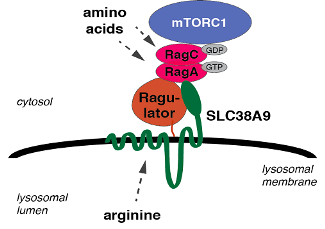Jan 9 2015
Known as much for its complexity as its vital role in regulating cellular and organismal growth, the mechanistic target of rapamycin complex 1 (mTORC1) pathway has seemingly been acting in mysterious ways.
 Scientists in the lab of Whitehead Member David Sabatini have for the first time identified a protein that appears to sense the amino acid arginine. The transmembrane protein, SLC38A9, depicted in the graphic at left, senses the presence of arginine and, via interactions with a family of enzymes known as RagGTPases, activates the mTORC1 growth-regulating metabolic pathway.
Scientists in the lab of Whitehead Member David Sabatini have for the first time identified a protein that appears to sense the amino acid arginine. The transmembrane protein, SLC38A9, depicted in the graphic at left, senses the presence of arginine and, via interactions with a family of enzymes known as RagGTPases, activates the mTORC1 growth-regulating metabolic pathway.
Through a variety of mechanistic interactions, mTORC1 interprets cues in the cellular environment, including the availability of nutrients, and signals the organism to act accordingly. mTORC1 is apt to trigger growth during times of abundance and dial back metabolism when food is scarce. Owing to years of intense scrutiny in the lab of Whitehead Institute Member David Sabatini, the key players of this pathway--whose deregulation is associated with diseases ranging from diabetes to cancer to epilepsy--have gradually been brought to light. Yet, one essential question remained unanswered: How exactly does mTORC1 actually detect the presence of nutrients?
Now, it seems, scientists in Sabatini's lab have at least a partial answer, describing for the first time a protein that appears to sense the amino acid arginine. The discovery of this transmembrane protein, known as SLC38A9, is reported this week in the journal Science.
"No one doubts that this is an important pathway, with implications for aging, cancer, and diabetes, and we had figured out the core machinery of the pathway," says Sabatini. "But the mystery has been what are the sensors? Now we've found what is likely the first nutrient sensor. This is what connects that core machinery to the world around it."
The finding suggests a model in which mTORC1, located at the surface of cellular components known as lysosomes, receives "go/no-go" signals from a family of enzymes dubbed Rag GTPases. It had been known that the Rags convey information about nutritional status to mTORC1, but it wasn't clear how the Rags came by this information. Through a series of experiments, researchers found that SLC38A9 is capable of transporting and directly interacting with amino acids, the building blocks of proteins. Further, they found that in cells overexpressing SLC38A9, mTORC1 signaling is activated even in the absence of amino acids. On the flipside, they found mTORC1 activation defective in cells engineered to lack expression of SLC38A9. Taken together, such compelling evidence points to SLC38A9 as an amino acid sensor, tipping off the Rags to the availability of nutrients.
"It's like a relay race and this protein is what starts the race," says Zhi-Yang Tsun, a graduate student in Sabatini's lab and co-first author of the Science paper. "We've been looking for a long time for a molecule like this. It has all the properties consistent with a sensor."
As new components of the pathway are identified and their roles elucidated, the number of potential targets that could be manipulated therapeutically increases. Historically, drug development activities in this space have focused on blocking mTORC1 activation, in part because hyperactivation of the pathway can lead to aberrant growth seen in cancer or metabolic abnormalities associated with diabetes. Intriguingly, because SLC38A9 activates the pathway, it may represent a target for clinical situations in which growth stimulation is desirable.
"It would be interesting to have to have small molecular handles to perturb the pathway, turning it on or off," says Shuyu Wang, another Sabatini lab graduate student and co-first author of the Science paper. "In this case, one could think about situations where you would want to increase protein synthesis, perhaps to treat muscle atrophy and disease-related weight loss."
Although the discovery of the first nutrient sensor in this pathway represents an important advance, the researchers know much work lies ahead. SLC38A9's specificity for arginine suggests that many more such sensors--for other amino acids and glucose, for example--interact either directly or indirectly with mTORC1. Identifying them will thus remain a focus of the lab for years to come.